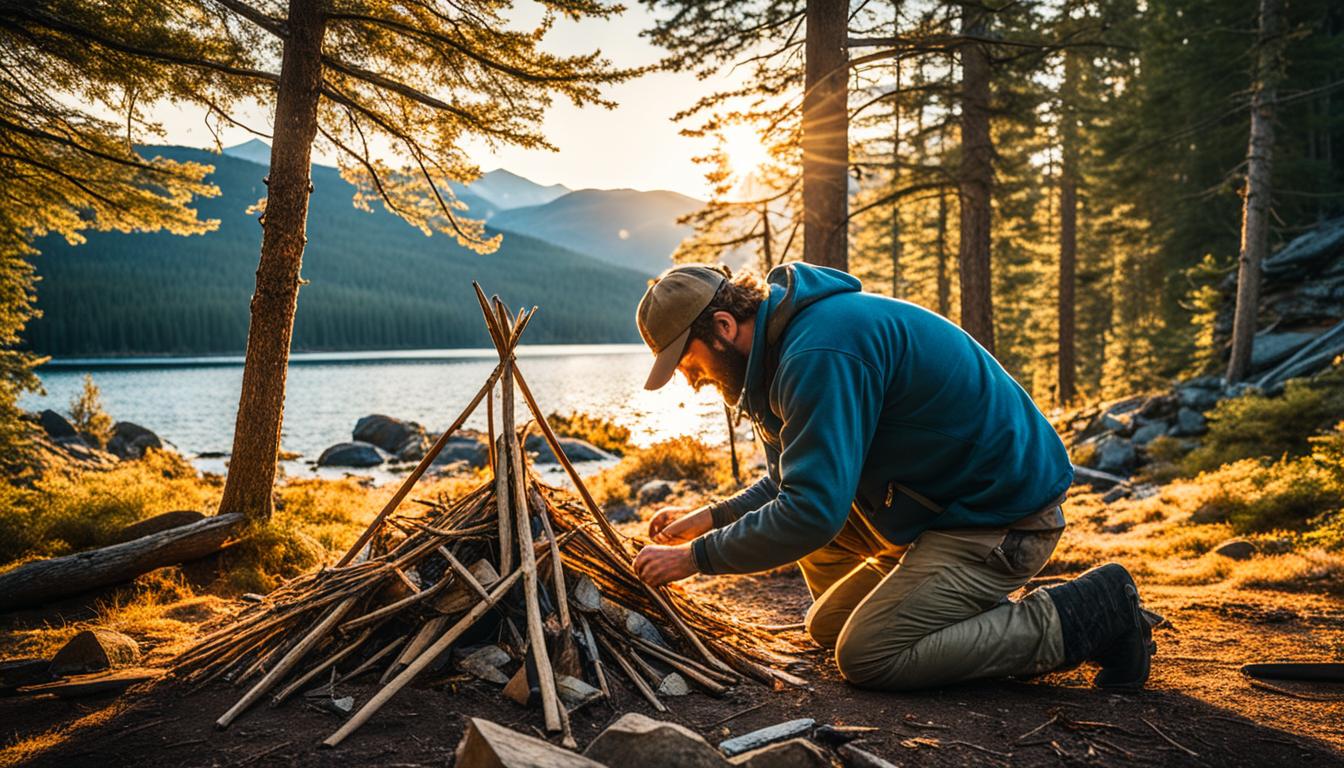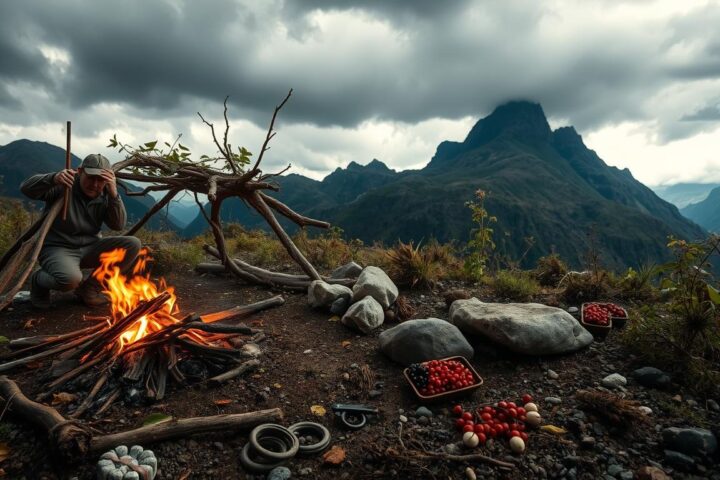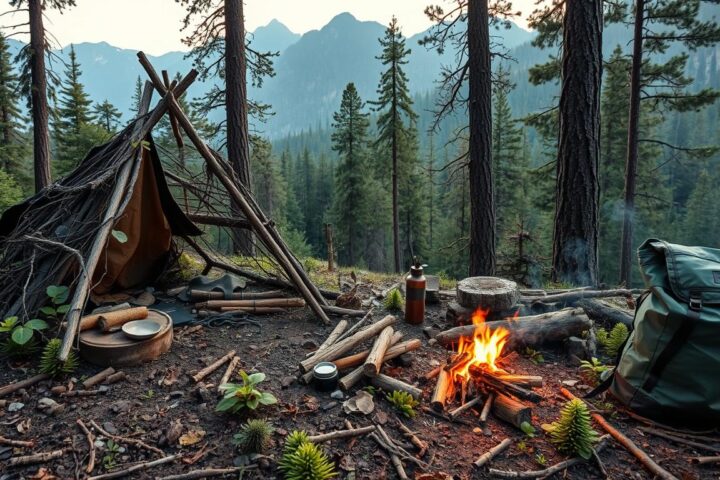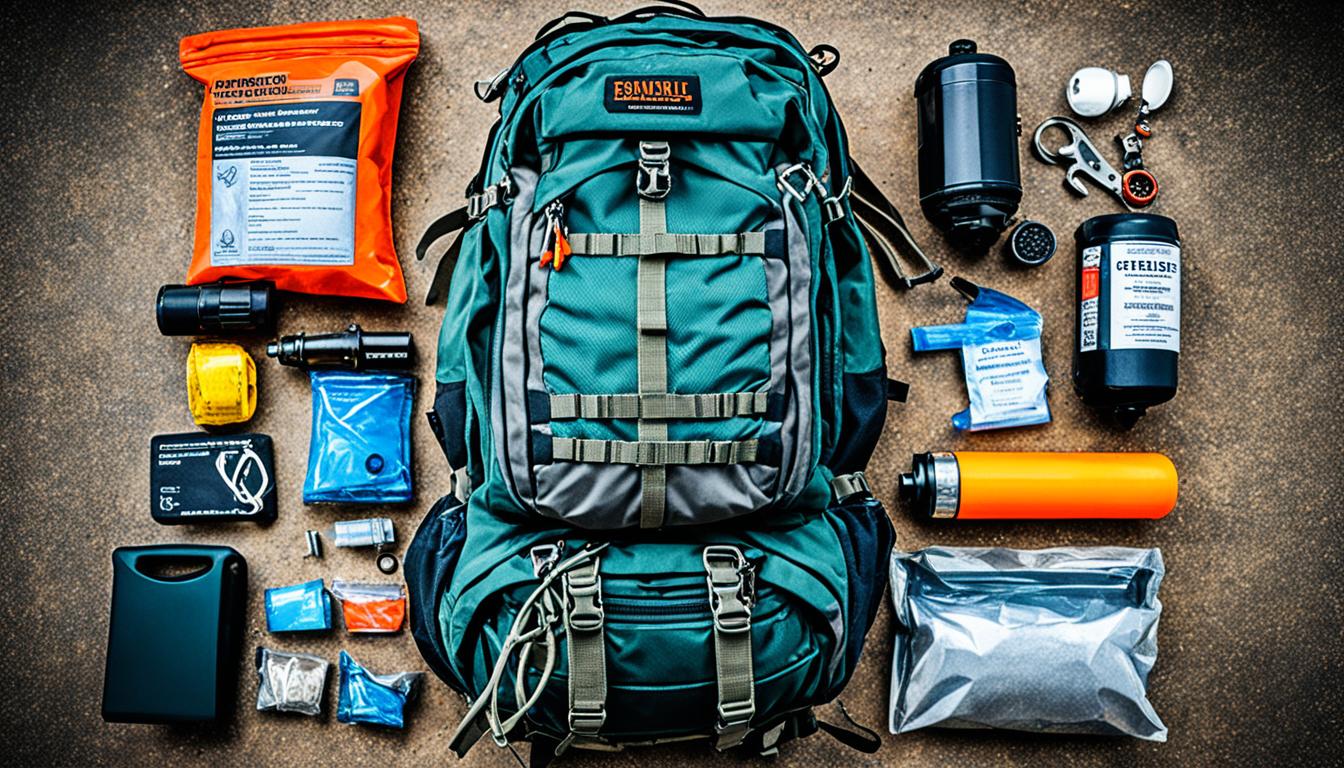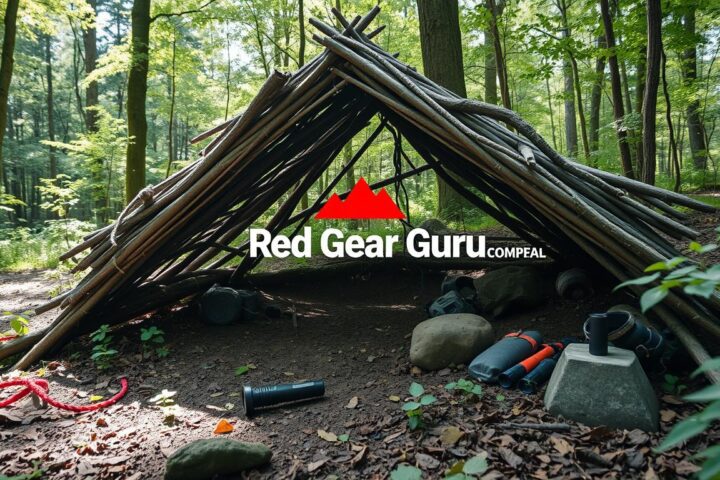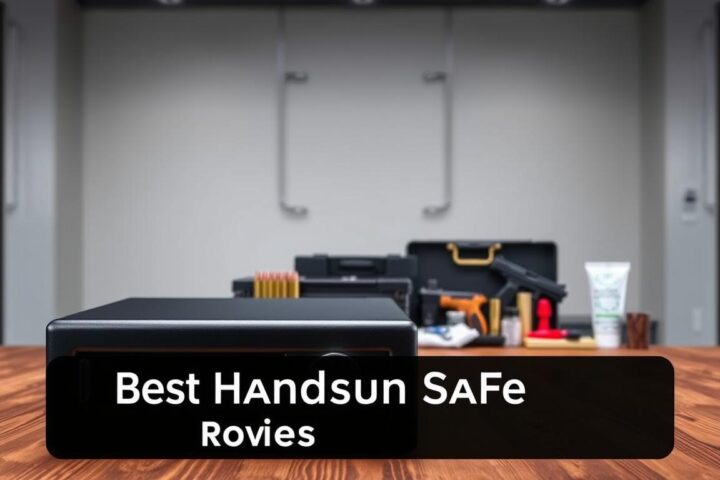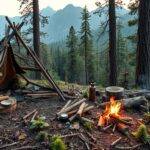Are you an adventurer looking to take on the great outdoors? Imagine being deep in the wilderness, surrounded by nature, when something unexpected happens. Would you know how to react and survive? Learning outdoor survival skills is key to adventure and safety.
This guide shares 10 essential tips for adventurers. We’ll cover planning and mastering important techniques. You’ll learn how to face any challenge with confidence. Get ready for a journey of discovery and outdoor fun.
Going into the great outdoors is thrilling, but you need the right skills for safety and fun. Let’s explore outdoor survival skills together. You’ll learn how to prepare, navigate, build shelters, find water, and make fire. Let’s discover how to thrive in the wilderness.
Prepare and Plan Ahead
Planning for outdoor survival is key to a safe and fun wilderness trip. Before you go, learn about the area, the weather, and what challenges you might face. Make a detailed plan and share it with others. This way, someone will know where you are and can help if needed.
It’s important to pack the right essential survival gear. You’ll need a map, compass, the right clothes, a first aid kit, and tools to start a fire. Planning and preparing means you’re ready for a safer and more fun trip.
Here’s a checklist of must-have survival supplies for your outdoor survival planning and wilderness trip preparation:
- Map and compass
- Water purification method
- Durable knife or multi-tool
- Weatherproof matches or lighter
- Warm, insulating layers of clothing
- Emergency shelter (e.g., tarp, bivy sack)
- First aid kit with essential medical supplies
- High-calorie, non-perishable food items
- Signaling devices (e.g., whistle, mirror, flares)
- Headlamp or flashlight with extra batteries
Planning and preparing well sets you up for a safe and successful outdoor adventure. Remember, being ready for emergencies and having the right gear is crucial in the wilderness.
Master Navigation Techniques
Learning to navigate the wilderness with confidence is key for adventurers. Knowing how to read topographic maps, use a compass, and understand GPS devices is crucial. These skills can turn a good trip into a great one or a bad situation into a safe one. Start by learning these important outdoor wayfinding techniques.
Improving your orienteering skills is a good first step. Practice taking bearings, figuring out where you are, and spotting natural landmarks. These skills are very useful when your GPS doesn’t work or you’re in a place with no cell signal.
Learning to use a compass is also important. But don’t forget about topographic maps. They show the terrain, elevation, and obstacles you might face. Always carry a map of the area you’re going to explore. Get to know the map’s symbols and features before you go.
Technology can help, but knowing wilderness navigation skills is key. Use your knowledge of maps, compasses, and the stars to navigate. This way, you can handle tough terrains with ease.
Getting good at wilderness navigation takes time and practice. Invest in quality gear like a reliable compass and a strong topographic map. Spend time learning how to use them. With effort and a desire to learn, you’ll be able to navigate the outdoors with confidence, no matter what.
Check out the best concealed carryto stay safe and comfortable in the wilderness.
Build a Shelter
When you go into the wilderness, making a good shelter is key. It keeps you safe and comfortable. You need to pick a spot that’s already protected and use what’s around you to build your shelter.
One way to make a shelter is with a debris hut. Use fallen branches, leaves, and other stuff to build a strong, warm shelter. Or, you can make a lean-to by leaning big sticks against a tree or rock. Then, fill in the spaces with smaller sticks, leaves, and other stuff to keep it warm.
In cold places, think about making a snow cave or igloo. These use snow to keep you warm. Adding things like grass, leaves, or pine needles inside helps keep the heat in and protects you from the cold.
- Look around to find the best spot for your shelter. Think about water, building materials, and dangers.
- Collect things like branches, leaves, grass, and bark for your shelter. Make sure it’s strong and can stand up to the weather.
- Use leaves, grass, or pine needles to insulate your shelter. This helps keep you warm and safe from the cold.
- Try making different shelters like debris huts, lean-tos, or snow caves based on what you have and the weather.
Being able to make a good shelter is a key survival skill. Learning how to build shelters in the wilderness helps you face outdoor challenges safely. You’ll be ready for anything that comes your way.
Find and Purify Water
Finding clean drinking water is crucial in the wild. Your body can only last three days without water. So, it’s important to find and purify water sources quickly. The amount of water you can find varies by location.
To make sure the water is safe, use different ways to purify it. Boiling water for five minutes can kill most harmful organisms. But boiling it for ten minutes is even safer. Distilling water is another good method to remove impurities.
- Use UV light devices like the Steripen Sidewinder to kill harmful microbes in seconds.
- Try the solar water disinfection method (SODIS), which uses the sun to clean contaminated water for a day.
- Use chemical treatments like Katadyn’s Micropur tablets or Potable Aqua’s iodine tablets, which kill over 99% of harmful pathogens.
Even clear water in the wild can have many harmful microorganisms. Always purify water before drinking it to stay safe.
Learning how to purify water helps you survive in the wild. Having clean drinking water is key to staying alive.
Make Fire
Being able to start and keep a fire going is key in outdoor survival. Fire gives you warmth, a way to cook food, and a signal for help in emergencies. Always carry tools like waterproof matches, lighters, and ferrocerium rods. Knowing how to gather and prepare tinder and kindling helps get a fire started, even when the weather is tough.
It’s vital to know how to keep a fire safe and manage it in the wild. Experts say to clear a 10-foot circle around the fire to prevent accidents. Use small kindling, about 1-2 millimeters thick, to start, and larger kindling for bigger flames. Fuelwood, 1″-5″ in diameter, is needed to keep the fire burning.
Softwoods like Douglas Fir and Pines burn fast and hot, while hardwoods like Oaks and Maples burn slower but longer. Dead branches from downed trees are great for kindling and fuelwood. But, store them right to keep them dry, especially in wet weather.
The fire tipi design is a good way to start a survival fire because it lights quickly and produces a lot of heat. Always watch the fire and don’t leave it alone. Being flexible and positive will help you make a fire, even when it’s hard.
Fire safety is very important. Make sure to put out fires with water or dirt before leaving the spot. By learning how to make fires and keeping them safe, you’ll be ready for anything outdoors and ensure your survival.
Outdoor Survival Skills
Learning key outdoor survival skills is key to surviving in the wild. These skills include finding food, treating injuries, and staying safe from wildlife. They also cover signaling for help and keeping a positive mindset. Being adaptable and always learning is crucial for backcountry success.
Practicing survival skills at home builds your readiness for real situations. You can practice building fires, purifying water, and constructing shelters safely before heading out. This way, you’ll be mentally and physically prepared for challenges in the wild.
Knowing how to forage and make basic tools is vital. You can learn to identify plants, set traps, and make self-defense tools. Practicing these skills safely can boost your survival chances in emergencies.
Being good at navigating, knowing first aid, and staying alert to wildlife are also key. These skills make you ready for any wild challenge. By improving these skills, you’ll be more prepared for survival.
Secure Food and Forage
Learning how to find food in the wild is key to surviving. You can find food by identifying plants, berries, and fungi in your area. Keep a guidebook on wild edibles handy and know the rules and gear for hunting and fishing.
Foraging techniques are great for outdoor survival. Get to know wild foods like white-tailed deer, wild turkey, grasshoppers, and mushrooms. These can help when you’re hungry. But always be careful and get advice from experts to avoid dangerous plants.
Hunting and fishing can give you lots of protein. These skills help you stay fed in the wild. Keep learning about different wild foods to be ready for anything.
By using nature’s gifts, you can appreciate the world more. Learn from indigenous traditions that respect wild foods. This way, you connect with nature and become more self-sufficient.
Outdoor Survival First Aid and Medical Skills
Carrying a wilderness first aid kit is key for emergencies and injuries outdoors. Knowing CPR and how to treat injuries can save lives in remote areas.
It’s smart for outdoor lovers to take a wilderness first aid course. These courses teach you how to handle medical emergencies. You’ll learn to treat injuries and give CPR.
Don’t forget to include a survival medical kit in your gear. Items like tourniquets and wound dressings can be vital in an emergency.
Being proactive is also important. Knowing how to spot signs of hypothermia and dehydration can help you act fast. Being ready and aware can help you manage any medical issue during your outdoor trips.
Wildlife Awareness and Safety
Exploring the outdoors is thrilling, but knowing about the wildlife is key. Learning to spot dangerous animals and how to stay safe lets you live in harmony with nature. It’s important to know how to identify animals that could be a threat.
Wilderness animal identification is a vital skill. Learn to recognize bears, snakes, and dangerous insects. Knowing their behaviors and where they live helps you avoid them and stay safe.
For bear safety, keep your food away from bears. Don’t leave things with a strong smell in your camp. Always let bears know you’re there when you’re hiking. If you meet a bear, stay calm, don’t look it in the eyes, and slowly move away.
- Watch out for snakes and insects like rattlesnakes and black widows. Know what to do if you see them.
- Wear clothes that protect you, check for ticks, and stay alert to avoid snake and insect bites.
Knowing about the wildlife and being careful lets you enjoy nature’s beauty safely. You can fully experience the wilderness without risking your health.
Signal for Help
If you’re lost in the outdoors, knowing how to signal for help can save your life. It’s smart for outdoor lovers to carry various wilderness distress signals and devices. Tools like whistles, signal mirrors, and bright tarps or flags can help attract rescuers.
Learning to use fire and smoke signals is also key. You should know the distress signals, like three fires in a triangle, to show where you are during a rescue.
Knowing how to signal for help can really help in a rescue. Being ready with the right emergency signaling devices and knowing how to use them can boost your chances of getting found and rescued.
Being visible and making your location clear to search teams is crucial. With the right knowledge and tools, you can greatly increase your chances of being found and safely returning from the wilderness.
Conclusion
Learning outdoor survival skills makes you more confident and safe in the wild. This journey teaches you how to handle challenges nature brings. It’s great for both experienced adventurers and beginners.
Activities like bushcraft and campfire safety help you appreciate nature more. Skills like navigation and shelter-building make you more independent. These skills are also crucial in emergencies, helping you survive.
The journey of mastering outdoor survival skills is rewarding. It’s important to face challenges, learn from nature, and trust your skills. With the right knowledge and spirit, you can safely explore the wilderness and make lasting memories.
